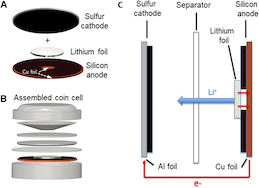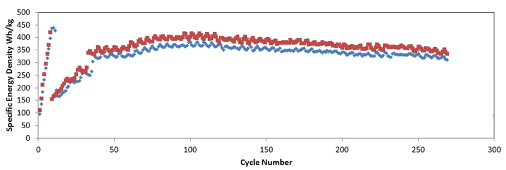Smart Battery Architecture For Sulfur Silicon Full Cells
Patent Status
| Country | Type | Number | Dated | Case |
| United States Of America | Issued Patent | 12,057,575 | 08/06/2024 | 2017-671 |
Full Description
Background
Sulfur is an attractive cathode material for Lithium-ion batteries (LiBs) due to its high theoretical capacity of 1675 mAh/g. Implementation has been slow due to inherent problems, such as, polysulfide shuttling, volumetric expansion and poor conductivity.
Current anode of choice for LiBs is silicon. The challenges with silicon are poor conductivity and volumetric expansion.
Researchers have identified techniques to alleviate the challenges with sulfur and silicon. This, however, has resulted in lesser focus on combining a sulfur cathode and a silicon anode - which is attractive because they are:
- environmentally benign;
- abundandtly available; and,
- offers a theoretical energy density of 1982 Wh/kg.
Technology
Researchers led by Prof. Cengiz Ozkan at UCR have developed a novel, patented, advanced LiB architecture with a sulfur cathode and silicon anode with lithium source integrated into the anode. The developed sulfur-silicon full cell (SSFC) exhibits an energy density of 350 Wh/kg and 95% coulombic efficiency for 260 cycles at a C/10 rate.

(A) SSFC battery architecture set up. (B) Assembled SSFC coin cell schematic. (C) SSFC cross sectional discharge schematic.

Deep galvanostatic cycling of the SSFC at C/10 for more than 250 cycles - charge (red) and discharge (blue).
Advantages
- The architecture allows for the controlled loading of lithium to compensate for the solid electrolyte interface (SEI) formation and degradation of lithium, which helps prolong the cycle life.
- Bypasses the complications of pre-lithiated cells.
- Serves as a platform for future SSFCs.
Suggested uses
- Motive and industrial energy storage applications
- Grid and stationary energy storage
- Consumer electronics, Drones, etc.
Additional Information
- Please see recent press coverage about this innovative battery architecture.
- Please see all innovations by Prof. Ozkan and his team at UCR.
Related Materials
Contact
- Venkata S. Krishnamurty
- venkata.krishnamurty@ucr.edu
- tel: View Phone Number.
Other Information
Keywords
lithium-ion battery, electrochemical energy storage, silicon anode, sulfur cathode, sulfur silicon battery, energy storage
